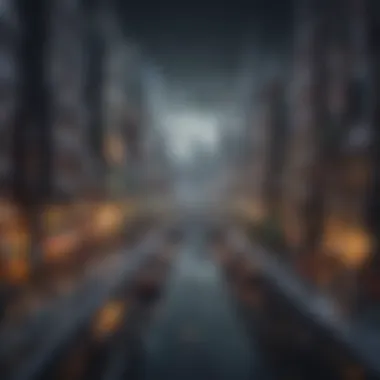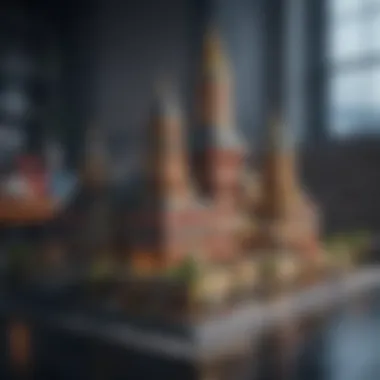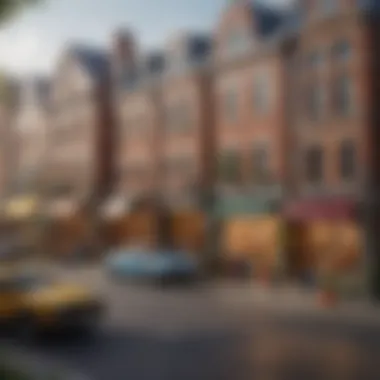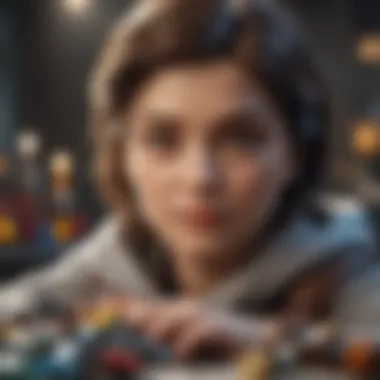Exploring Lego Ideas in 2022: A Comprehensive Overview


Intro
As we enter 2022, the landscape of Lego Ideas has unfolded into a vibrant tapestry of creativity and collaboration. This platform has transformed the way Lego enthusiasts think outside the box, giving them room to dream, design, and share their creations with a global audience. From fan-driven projects that spark inspiration to innovative builds that push the boundaries of imagination, Lego Ideas stands as a testament to what happens when a community comes together over a shared passion for building.
The past year has seen various projects ascend to popularity, showcasing the diverse interests within the fan base. Whether it's nostalgic tributes, futuristic designs, or playful interpretations of real-world structures, the spectrum of ideas on offer is as rich as the bricks themselves.
Before we delve into the intricate details of the year's most engaging projects, let's chart a course through the key trends and noteworthy challenges faced by creators on the Lego Ideas platform. Understanding these aspects not only enriches our appreciation for these builds but also highlights the ever-evolving nature of community-driven creativity.
Let's kick off this exploration with a closer look at the unique features that set Lego Ideas apart from other platforms.
Prelude to Lego Ideas
Lego Ideas has become a vital platform for fans and creators to express their innovative designs and concepts. This segment explores the significance of Lego Ideas within the broader realm of Lego in 2022. It isn't just a place for hobbyists to showcase their work; it acts as a bridge between the community and the brand, allowing for mutual influence and inspiration. Understanding this platform is crucial for anyone interested in Lego, be it for professional purposes or just for fun.
Through this lens, we can comprehend how individual creativity can come together to shape the future of Lego products. The collaborative nature of Lego Ideas enables seasoned builders and newcomers alike to share their visions, leading to projects that often capture a unique aspect of popular culture or technology. The connection between the builders' passion and Lego’s marketing strategy informs both the brand’s offerings and the fans’ expectations.
The Concept of Lego Ideas
At its core, Lego Ideas allows fans to submit their own creations, hoping to turn their designs into official Lego sets. But this is about more than just having your design in stores; it’s about community, recognition, and the joy of building. Creators gather support from fellow Lego enthusiasts who vote on submissions, giving them a sense of camaraderie.
Each submission needs to gain a certain threshold of votes to be considered. Once a project reaches this milestone, it enters the review process where it may become an actual set if it meets Lego’s criteria. This process underlines the grassroots nature of the platform and ensures that popular projects get the attention they deserve.
One notable aspect is the diversity in submissions. Whether it’s a model of a beloved movie scene or a functional gadget like a working clock, the creativity shows that the Lego brand transcends age and interests. Each project tells a story, connecting builders not just to the Lego brand but to each other.
Historical Context of Lego Ideas
The origins of Lego Ideas can be traced back to 2008 when it first launched as "Cuusoo," a Japanese word meaning "wish" or "desire." It allowed fans to propose their dreams of Lego sets. This evolution captures a pivotal shift in corporate practices, where listening to consumers became a crucial part of product development.
Over the years, various successful projects emerged from this platform, from the Minecraft sets to the iconic NASA Apollo Saturn V. The historical roots reflect not just the growth of Lego Ideas, but also the increasing importance of community feedback in shaping product lines.
"Lego Ideas serves as a testament to the brand's commitment to fan engagement. It shows that Lego isn't just about blocks and designs; it’s about creativity thriving in a community of like-minded individuals."
This history informs our understanding of how Lego Ideas has transformed from a simple suggestion box into a dynamic space that fosters creativity and innovation. As we dig into the next sections, it’s essential to keep in mind the backdrop against which Lego Ideas has developed, shaping the trends of 2022.
Lego Ideas Overview for
The concept of Lego Ideas serves as a fascinating window into how creativity and community fuse to shape the Lego landscape. In 2022, this platform became a vital space for fans, not just to express their ideas but to witness those ideas move closer to reality through enthusiastic backing. This section delves into key elements that define Lego Ideas in 2022, highlighting emerging trends and the common themes that arose from submissions.
Emerging Trends in
2022 was quite the year for Lego Ideas, as it saw a surge in projects rooted in nostalgia and contemporary culture. Many submissions paid homage to beloved franchises such as Star Wars and Harry Potter, resonating with fans who wish to relive those cherished moments. It's not just about fairy tale magic, though; the rise of sustainability as a theme made waves. Builders expressed a desire to create more eco-friendly sets, showcasing a trend towards awareness regarding environmental concerns.


In addition, the blending of various pop culture phenomena became increasingly prevalent. For example, one proposal might combine elements of comic book heroes with classic architecture, drawing the attention of diverse audiences. This crossover appeal not only reflects the interests of younger builders but also rekindles the imagination of older fans.
The innovative use of technologies such as augmented reality in some designs began to appear as well. Imagine being able to tour a Lego creation digitally, peering into intricate details beyond the plastic bricks. That's the kind of creative energy that's fueling the future of Lego Ideas. This trend of interactivity is set to redefine how users engage with their creations.
Significant Themes from Submissions
Within the expansive array of submissions to Lego Ideas, certain themes stood out as particularly influential in 2022. From these projects, we can grasp the evolving interests and concerns of the community.
- Nostalgia: Many projects leaned heavily on nostalgia, tapping into the collective memory of toys and shows that people grew up with. Builders submitted designs that reflected their childhood joys, paving the way for new generations to experience these themes.
- Community and Collaboration: A noticeable increase in collaborative projects showed the strength found in community efforts. Groups of builders rallied to combine their talents, often resulting in richer, more detailed submissions.
- Diversity: There was a marked push for representation, with many builders incorporating cultural symbols and designs from various backgrounds. This not only enriches the storytelling potential of Lego but also engages a wider audience.
- Innovation: The drive for such unique themes is mirrored in the innovative building techniques employed by creators. As builders share tips and techniques on forums like reddit.com, knowledge exchange fosters a culture of creativity where everyone can learn from one another.
The Most Popular Lego Ideas Projects of
In the realm of Lego Ideas, the projects that capture the collective imagination are not just whims sprinkled across the platform; they serve as vital touchpoints for creativity and community. The most popular Lego Ideas projects of 2022 reveal not just trends in design but also the shifting dynamics within the Lego community itself. These projects highlight the creativity of individuals as they converge with a shared love for building and storytelling through these colorful bricks.
Highlighting Selected Projects
Every year, numerous submissions flood the Lego Ideas platform. However, a handful of these projects stand out for their originality and appeal. In 2022, among the notable projects were:
- The Blue Sky Gallery: A tribute to the wonder of art and observation, designed to showcase mini masterpieces. This project combined elements of modern architecture with the joy of creativity, making it a favorite.
- The Jurassic World: Velociraptor Chase: This was a fan-favorite, appealing to the younger crowd and adults alike, blending action and nostalgia from the iconic film series. Each piece contributed to a dynamic scene that sparked much enthusiasm.
- Lego Space Station: A re-imagining of space exploration, showcasing thoughtful engineering and aesthetics. It’s a nod to both today’s understanding of outer space and an inspiration for future generations.
These selections didn’t just earn the spotlight; they resonated with a broader audience, showcasing what passionate builders can achieve when given the chance. People appreciated their stories just as much as the designs, weaving together personal connections and shared history.
Analysis of Successful Proposals
The essence of successful Lego Ideas projects lies in the fine balance they strike between creativity, feasibility, and community interest. Looking into the proposals that garnered high levels of support in 2022 reveals several critical aspects:
- Community Engagement: Projects that actively engaged with the community through social media platforms, like Facebook and Reddit, gained traction. Creators who took the time to respond to feedback or share progress updates earned a loyal following.
- Innovation and Originality: The most successful designs pushed the envelope in terms of creativity. Projects that introduced elements or themes not previously explored by Lego often grabbed attention. Unique concepts likethe Blue Sky Gallery’s art aspect showed how innovation paired with passion can result in something extraordinary.
- Buildability: While creativity is essential, so is practicality. Proposals that demonstrated thoughtful construction techniques and proper scale tended to resonate more. Many builders prioritized showcasing their designs' structural integrity while ensuring ease of assembly. Users often commented on how such attention to detail improved their experience.
Each of these elements played a pivotal role in elevating projects from mere concepts to emblematic representations of what the Lego Ideas community stands for.
As we explore the threads that connect these projects, it's clear that the most popular Legos Ideas projects of 2022 served not just as creative outlets but also as a bridge bringing together the diverse Lego community, proving that every brick tells a story.
Community Engagement and Impact
The essence of Lego Ideas thrives on the vibrancy and input of its community. In 2022, this dynamic relationship fostered a unique environment where creativity flourished not merely in isolation but within a collective. Engaging enthusiasts in this creative process results in rich idea development, influences project trajectories, and amplifies the overall impact on both aspiring and established Lego fans.
Role of the Community in Idea Development
Community participation serves as the backbone of idea development within the Lego Ideas platform. Each submission is not just a standalone creation; it's a collective effort nurtured through feedback, discussions, and encouragement from fellow members. For instance, many projects saw a significant influx of supporters thanks to community votes, where patrons rally behind a creator's vision, boosting its visibility.
When looking at diverse submissions, one can notice that the most successful projects often incorporate elements that resonate well with the community. Whether it's an homage to a beloved pop culture reference or a design that triggers nostalgia, community feedback directs these innovative designs toward the right target. This interaction fosters an iterative process where ideas can be refined based on diverse perspectives, ultimately leading to a more polished final product.


Additionally, social media platforms play an instrumental role. Online forums, dedicated subreddits like those on reddit.com, and tailored Facebook groups enable creators to present their concepts early in the design phase. Here, enthusiasts may critique, suggest improvements or even collaborate, engendering a sense of partnership that extends beyond geographic boundaries. With every iteration, designers cultivate relationships with their audience, resulting in a sense of ownership among supporters, which can considerably increase project momentum.
Feedback Mechanisms Within the Platform
In the context of Lego Ideas, feedback mechanisms are crucial. They provide a structured way for the community to share thoughts and insights on submissions. Through comment sections, users can communicate what they love about a project or point out areas for enhancement. This engagement works in two key ways:
- Constructive Criticism: Encouraging creators to refine and enhance their designs. This constructive feedback often leads to a better understanding of what the community desires, which in turn influences future projects. For example, a creator might receive suggestions about color schemes or features that could make their design more appealing.
- Public Validation: Displaying community support through votes or comments can exponentially increase a project's visibility. When a submission garners significant attention, prospective creators are likely to take note and analyze why certain projects resonate more strongly.
More than just a simplistic way to gather opinions, these feedback loops cultivate an environment where transparency and collaboration reign supreme. They become a home for ideas to bounce around and evolve through discourse.
“In the world of Lego Ideas, every piece matters, and every voice counts. The collaborative spirit elevates individual creativity to new heights.”
Challenges Faced by Creators
Creating within the Lego Ideas framework can be thrilling, but there are undeniable challenges that every builder faces. Understanding these challenges is vital, not just for current and aspiring creators, but also for the Lego community as a whole. The struggles that occur during the creative process often shape the kinds of ideas that make it through the approval stages, influencing the community’s output.
Navigating the Approval Process
One of the biggest hurdles for any creator on the Lego Ideas platform is the approval process itself. This process ensures that submitted ideas meet certain criteria before they can be crafted into actual sets. It can be a nail-biting journey for those who have invested time and creativity into their projects. Here are a few important aspects to ponder:
- Understanding Submission Guidelines: Every submission must adhere to specific guidelines; failing to do so often results in immediate rejection. Familiarity with these guidelines is non-negotiable and should be a creator’s first step.
- The Role of the 10,000 Supporters: To even get a shot at approval, a project requires 10,000 votes from the community. This milestone can create a major sense of pressure. Not only is it about sharing the project widely, but also persuading others to appreciate the vision behind the model.
- Time and Patience: After reaching the supporter threshold, the waiting period can feel like eternity. Creators often experience anxiety, wondering if they will receive the coveted green light.
Common Pitfalls and Missteps
While pursuing creativity, many creators trip over common pitfalls. Recognizing these missteps not only helps in avoiding them but can also lead to personal growth. Here are frequent errors encountered:
- Overcomplicating Designs: In an effort to wow potential supporters, creators sometimes overload their designs. Simple, elegant solutions often resonate more effectively and remain more focusable.
- Ignoring Feedback: Community feedback can be invaluable. Some creators may be reluctant to modify their designs, thinking their original idea is perfect. Remaining open to constructive criticism can propel projects toward success.
- Underestimating Community Engagement: Many creators might believe that just having a great idea is enough. However, actively engaging with the community, sharing progress, and participating in discussions can significantly enhance visibility and support.
"Success in Lego Ideas requires both passion and perseverance; understanding the roadblocks can turn uncertainties into stepping stones."
By traversing these challenges head-on, Lego creators not only refine their skills but also contribute to a richer and more diverse Lego Ideas community. Having a clear grasp of the approval process and keen awareness of potential pitfalls equips builders with the tools needed to enhance their chance of success in this imaginative realm. This understanding sets the stage for a more fruitful creative journey.
Noteworthy Collaborations and Partnerships
The landscape of Lego Ideas is not just confined to individual creativity. The power of collaborations and partnerships significantly shakes things up, lending greater depth to the projects emerging each year. These partnerships, whether with peers in the Lego community or corporate entities, enhance the creative potential available to designers. By joining forces, creators can fuse their styles and ideas, which leads to innovative designs that captivate a broader audience.
When we talk about Noteworthy Collaborations and Partnerships, the underlying benefits are manifold. Collaborations enable resource-sharing, where creators can pool their skills for a project that one might struggle to execute alone. With the Lego Ideas platform, it's essential to tap into different perspectives, fostering an environment in which unique project visions can flourish along with community enthusiasm.
Collaborative Projects with Renowned Creators
In 2022, we witnessed several collaborative projects that stood out for their creativity and uniqueness. Renowned creators, often with established followings, played a pivotal role in showcasing how partnership in creative endeavors can elevate the final product. For instance, the collaboration between Toys & Gears and Blocksleuth attracted considerable attention with their homage to famous landmarks, effectively reflecting the creative synergy that comes from jointly shared skills.


Not only did these collaborations result in striking designs, but they also highlighted the social aspect of building. Creators shared the narrative of their partnership, developing it into engaging stories that resonated with fans. It often spurred more interest and deeper connections with the audience, causing projects like this to soar in ratings on platforms like Reddit and Lego discussions.
Corporate Partnerships and Thematic Sets
Corporate partnerships have also become a frequent recommendation for enhancing Lego Idea projects. In 2022, companies began to collaborate more closely with enthusiastic builders to create thematic sets that echo brand values or iconic worlds. These partnerships are not only beneficial for corporate branding, but they also introduce exciting new themes into the Lego universe.
The Star Wars franchise, for example, has long had a relationship with Lego, but recent collaborations added fresh thematic sets that were directly influenced by the latest movie releases. Such corporate partnerships allow creators to pitch ideas that coincide with popular media, increasing the chances of approval while tapping into existing fanbases.
Engaging in collaborative efforts, whether with individuals or corporations, enhances creativity and allows for thematic depth that might otherwise remain untapped.
In summary, engaging in noteworthy collaborations and partnerships is vital for the evolving landscape of Lego Ideas. They bolster community engagement and bring together a wider array of talents and resources that appeal to fans who are ever hungry for new excitement and creativity in their building experiences.
The Future of Lego Ideas
Examining the future of Lego Ideas is crucial for understanding how this platform will evolve in response to community engagement and innovative thinking. As Lego continues to tap into the imaginations of its fans, the parameters defining successful submissions will also shift, creating new opportunities for creators and enriching the diversity of available sets.
Anticipated Trends for and Beyond
Looking ahead, there are several trends that seem poised to reshape the Lego Ideas landscape.
- Increased Focus on Sustainability: Environmentally-conscious sets will likely become more prevalent. As society emphasizes ecological responsibility, projects that integrate sustainable materials or promote environmental themes may gain popularity. Creators who harness this growing sentiment can capture the interest of a conscientious audience.
- Incorporation of Technology: The merging of bricks with tech is unavoidable. Expect submissions that incorporate AR and VR features, as well as digital expansions that bring builds to life in new ways. This shift will likely attract a younger demographic who are digitally literate.
- Niche Themes and Cultural Representation: We can anticipate Lego to encourage more niche concepts, celebrating varied cultures and stories. Projects focusing on lesser-known mythology, historic events, or local symbolism may resonate well with a global audience, broadening the appeal beyond mainstream pop culture.
- Collaborations with Popular Media: Partnerships with movies, video games, or shows will remain strong. The success of collaborations, such as those seen in recent years, will spur creators to develop ideas that align with notable franchises, ensuring relevance in an increasingly competitive market.
"The creativity from fans is boundless. As they push boundaries, the Lego Ideas platform will flourish in its variety and depth, all while remaining connected to current cultural narratives."
Evolving Community Dynamics
The interactions within the Lego Ideas community are shifting. More than just a platform for submission, it's evolving into a dynamic ecosystem where relationships thrive on feedback, collaboration, and shared passion.
- Increased Collaboration: Community projects may see a rise, where multiple creators join forces on ideas. This not only enhances creativity but also fosters camaraderie among members. Such collaborations can lead to richer concepts that individual creators might not have considered.
- Greater Emphasis on Feedback: The significance of constructive criticism has never been more pronounced. Creators who actively seek and embrace feedback can enhance their proposals and refine their concepts. This culture of improvement will contribute to raising the overall quality of submissions on the platform.
- Engagement Across Platforms: Social media will continue to play a vital role in shaping discussions. Platforms like Twitter or Reddit provide spaces where creators can gain insights, share their process, and connect with enthusiasts globally. Insights derived from these interactions enrich the community feedback loop, influencing either future proposals or collaborative efforts.
Epilogue
Wrapping up our journey through the landscape of Lego Ideas in 2022, we can appreciate not only the creativity displayed but also the sense of community that drives this initiative. The importance of this topic lies in how it highlights the symbiosis between creators and connoisseurs of Lego. The platform acts as a bridge, connecting innovators with a willing audience ready to embrace their visions.
Innovation in design often germinates from the collaborative spirit fostered by the Lego Ideas community. Projects born in this vibrant ecosystem can achieve remarkable success, bringing to life fantastical concepts that resonate with fans worldwide. As we consider the benefits of engaging with Lego Ideas, we notice how it encourages imaginative play, cultivates a community of passionate creators, and allows people of all ages to express themselves artistically.
Equally, the challenges faced by creators provide crucial insights. Navigating approval processes, managing expectations, and learning from feedback are aspects that not only define the creator’s journey but also speak to the evolving nature of Lego as a brand that values input from its users. It's a cycle where success breeds more innovation and sets the stage for future creativity.
As we conclude, it’s clear that Lego Ideas isn’t just about constructing models; it's about building connections, sharing experiences, and fostering creativity across the globe.
Summary of Key Takeaways
- Community Driven: The Lego Ideas platform is heavily influenced by its community, making it essential for creators to engage meaningfully with fans and other builders.
- Encouragement of Creativity: Lego Ideas allows the blending of imagination and technicality, empowering builders to express diverse concepts, from intricate designs to unique storytelling.
- Challenges and Growth: The hurdles faced by creators often lead to learning opportunities, strengthening both the platform and its creative output.
- Future Potential: As we reflect on 2022, the potential for growth and innovation in 2023 and beyond is immense, with an ever-evolving community eager to see their ideas come to life.
Final Thoughts on Lego Ideas
Lego Ideas in 2022 was certainly a canvas painted with diverse strokes, showcasing a richly textured collection of creativity and passion. The significance extends beyond just the bricks; it reflects a culture of collaboration and shared joy in building. From intricate structures to playful concepts, the projects brought forth encompass a wide range of emotions, stories, and aspirations.
Looking ahead, the foundation laid in 2022 serves as a launchpad for even bolder ideas to take flight. As we anticipate the blossoming innovations, it’s worthwhile for both creators and fans alike to immerse themselves in this engaging realm of Lego Ideas. To paraphrase a common saying, with every brick laid, a story unfolds, keeping alive the magic of imagination and creativity—traits that Lego has long championed.







